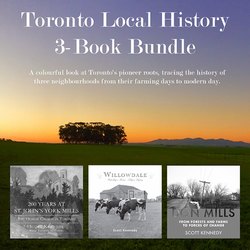Читать книгу Toronto Local History 3-Book Bundle - Scott Kennedy - Страница 15
На сайте Литреса книга снята с продажи.
{Chapter Eight}
ОглавлениеJohn D. Finch’s Farm
Innkeeper and farmer John Finch may not be familiar to modern-day Torontonians, but the avenue that honours him is as familiar to them as their own names. Finch Avenue traverses almost the entire city, from the Humber River in the west to the Rouge River in the east. It is one of the busiest routes in Toronto, encompassing all aspects of our city, from the gritty urban landscape of the Jane/Finch corridor to the leafy silence of the Rouge Valley National Park.
The route was named in the late 1800s, while the Finches were still living on their farm, which ran along the north side of Finch Avenue between Yonge Street and Bayview, on the southern half of Lot 21-1E. While the family worked a relatively small farm, it would be John’s other occupation that would prove the source of his immortality, for John operated two of the finest inns in the area. Quenching thirsts, filling bellies, and offering warm beds to weary travellers for nearly forty years made him one of North York’s more valuable citizens, and earned him the recognition he is still afforded today.
The lot John Finch settled on had first been granted to Thomas Johnson in 1800. The Johnsons were one of the first families to settle in North York, arriving from their native Pennsylvania in the late 1700s. Thomas farmed there for eleven years, after which time the lot went through a series of uncommitted owners before John Montgomery and his father Alexander took it over in 1815. Their bizarre story is revealed in the chapter on the Montgomery/Elliot Farm.
Sometime around 1833, John Finch rented The Bird in Hand Inn from John Montgomery, who had built it in 1820 with his father’s assistance, just south of today’s Newtonbrook Plaza. Some six years earlier, in 1827, following a bitter family dispute and a court order, the building had been literally cut in half, with Alexander retiring to his residence in the north half of the building and John continuing to operate the tavern in the southern half. When John Finch rented the property, John Montgomery headed south to Yonge and Eglinton to build the most notorious tavern in Canada’s history. By the time the Upper Canada Rebellion was launched from Montgomery’s Tavern in 1837, John Finch was maintaining his neutrality and concentrating on the continuing success of The Bird in Hand. By all accounts, he did a commendable job, since his inn was held in high regard by local travellers for the excellent food, lodging, and libations it provided.
The Bedford Park Hotel, formerly Finch’s Hotel, looms over its newer neighbours on the southwest corner of Yonge Street and Fairlawn Avenue in this 1955 photograph taken by Ted Chirnside.
Courtesy of Toronto Public Library, TC 63.
The Finch family farmhouse at 5611 Yonge Street, pictured here in early 1973, was demolished in 1977 to make way for low-rise retail and offices.
Photo by Barbara Sabo, North York Historical Society, NYHS 1537.
In 1847, John bought the inn and the southern half of the farm from the Montgomerys. He then closed the inn and built a new hotel on the northeast corner of Yonge and Finch. He called his new establishment Finch’s Hotel and placed an advertisement in The British Colonist of September 20, 1848. The ad stated that John had:
… opened a new and capacious hotel on Yonge Street, situated within a quarter of a mile of the premises formerly occupied by the subscriber.… The house and outbuildings are entirely new.… The subscriber will always take care to have his larder well stored and his Wine and Spirit Cellar well supplied with genuine articles … his stabling shall be well regulated, so that every comfort … may at all times be depended upon at Finch’s Hotel.
The new, two-storey frame hotel proved even more popular than its predecessor, becoming a destination in its own right, rather than just a stop along the way.
John continued as the proprietor of Finch’s Hotel until he retired in 1860. The hotel was then leased to a series of innkeepers: Thomas Palmer in 1860, John Likens in 1864, James Fenley in 1869, and William Kirk in 1871. In 1873, John sold the hotel to Charles McBride, who dismantled it and used the timbers to build the Bedford Park Hotel on his farm at the corner of Yonge Street and Fairlawn Avenue. The hotel stood, obscured by various storefronts, until the 1980s. John Finch died in 1884, leaving the farm to his family, who continued to work the land well into the twentieth century.
The 1920s brought rapid change to North York. The advent of the automobile, more roads, and improved public transportation all conspired to make it easy for people to live in North York and work in Toronto. The rural society was being swallowed up by the urban society and nowhere was it more noticeable than along main roads such as Finch Avenue. Farmers sold individual lots for new houses and even began to subdivide their land for the construction of blocks of new houses. And so, piece by piece, John Finch’s farm began to disappear.
Today, there is nothing left of his former farm. The Finch family farmhouses stood on the northeast corner of Yonge and Finch until they were demolished in 1977, over 140 years after John Finch signed the lease on The Bird in Hand.
This view, captured by photographer Ted Chirnside in 1957, looking northeast across the intersection of Yonge Street and Finch Avenue, would remain surprisingly unchanged for the next twenty years. Two Finch family farmhouses stand to the north of the Bank of Nova Scotia at 5611 and 5617 Yonge Street.
Courtesy of Toronto Public Library, TC 201.
